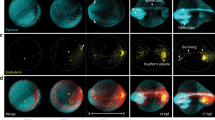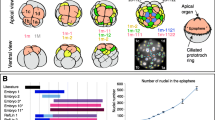Abstract
We describe a set of observations on developing zebrafish embryos and discuss the main conclusions they allow:(1) the embryonic dorso-ventral polarity axis is morphologically distinguishable prior to the onset of gastrulation; and (2) the involution of deep layer cells starts on the prospective dorsal side of the embryo. An asymmetry can be distinguished in the organization of the blastomeres in the zebrafish blastula at the 30% epiboly stage, in that one sector of the blastoderm is thicker than the other. Dye-labelling experiments with DiI and DiO and histological analysis allow us to conclude that the embryonic shield will form on the thinner side of the blastoderm. Therefore, this side corresponds to the prospective dorsal side of the embryo. Simultaneous injections of dyes on the thinner side of the blastoderm and on the opposite side show that involution of deep layer cells during gastrulation starts at the site at which the embryonic shield will form and extends from here to the prospective ventral regions of the germ ring.
Similar content being viewed by others
References
Davidson EH (1990) How embryos work: a comparative view of diverse modes of cell fate specification. Development 108: 365–389
Fleig R (1990) Gastrulation in the zebrafish, Brachydanio rerio (teleostei) as seen in the scanning electron microscope. In: Marthy HJ (ed) Experimental embryology in aquatic plants and animals. Plenum Press, New York, pp 329–338
Gurdon JB (1987) Embryonic induction — molecular prospects. Development 99: 285–306
Hamano S (1964) A time-lapse cinematographic study on gastrulation in the zebrafish. Acta Embryol Morphol Exp 7: 42–48
Hammerschmidt M, Nusslein-Volhard C (1993) The expression of a zebrafish gene homologous to Drosophila snail suggests a conserved function in invertebrate and vertebrate gastrulation. Development 119: 1107–1118
Hisaoka KK, Battle HI (1958) The normal developmental stages of the zebrafish, Brachydanio rerio (Hamilton-Buchanan). J Morphol 102: 311–328
Hisaoka KK, Firlit CF (1960) Further studies on the embryonic development of the zebrafish, Brachydanio rerio (Hamilton-Buchanan). J Morphol 107:205–255
Ho RK (1992) Axis formation in the embryo of the zebrafish, Brachydanio rerio. Semin Dev. Biol 3:53–64
Honig MG, Hume RI (1986) Fluorescent carbocyanine dyes allow living neurons of identified origin to be studied in long-term cultures. J Cell Biol 103: 171–187
Jacobson AG, Sater AK (1988) Features of embryonic induction. Development 104: 341–359
Kimmel CB, Law RD (1985a) Cell lineage of the zebrafish blastomeres. II. Formation of the yolk syncytial layer. Dev Biol 108:86–93
Kimmel CB, Law RD (1985b) Cell lineage of the zebrafish blastomeres. III. Clonal analysis of the blastula and gastrula stages. Dev Biol 108:94–101
Kimmel CB, Warga RM, Schilling TF (1990) Origin and organization of the zebrafish fate map. Development 108: 581–594
Oppenheimer JM (1936) Structures developed in amphibians by implantation of living fish organizer. Proc Soc Exp Biol Med 34:461–469
Oppenheimer JM (1939) The capacity for differentiation of fish embryonic tissues implanted into amphibian embryos. J Exp Zool 80:391–421
Pasteels J (1936) Etudes sur la gastrulation des vertebrates méroblastiques. I. Teleostéens. Arch Biol 47:205–308
Schmitz B, Papan C, Campos-Ortega JA (1993) Neurulation in the anterior trunk region of the zebrafish, Brachydanio rerio. Roux Arch Dev Biol 202: 250–259
Schulte-Merker S, Ho R, Herrmann B, Nusslein-Volhard C (1992) The protein product of the zebrafish homologue of the mouse T gene is expressed in nuclei of the germ ring and the notochord of the early embryo. Development 116:1021–1032
Schulte-Merker S, Hammerschmidt M, Beuchle D, Cho KW, De Robertis EM, Nüsslein-Volhard C (1994) Expression of the zebrafish goosecoid and no tail gene products in the wild-type and mutant ntl embryos. Development (in press)
Stachel SE, Grunwald DJ, Myers PZ (1993) Lithium perturbation and goosecoid expression identify a dorsal specification pathway in the pregastrula zebrafish. Development 117:1261–1274
Thisse C, Thisse B, Schilling TF, Postlethwait J (1993) Structure of the zebrafish snail1 gene and its expression in wild-type, spadetail and no tail mutant embryos. Development 119: 1203–1215
Warga RM, Kimmel CB (1990) Cell movements during epiboly and gastrulation in zebrafish. Development 108: 569–580
Westerfield (1989) The zebrafish book. Oregon Press, Portland
Woods A, Timmermans LPM (1988) Teleost epiboly: a reassessment of deep cell movement in the germ ring. Development 102:575–585
Author information
Authors and Affiliations
Rights and permissions
About this article
Cite this article
Schmitz, B., Campos-Ortega, J.A. Dorso-ventral polarity of the zebrafish embryo is distinguishable prior to the onset of gastrulation. Roux's Arch Dev Biol 203, 374–380 (1994). https://doi.org/10.1007/BF00188685
Received:
Revised:
Issue Date:
DOI: https://doi.org/10.1007/BF00188685




